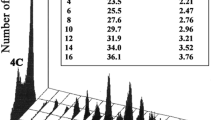Abstract
Scheduled (SDS) and unscheduled (UDS) DNA synthesis as well as nucleoid sedimentation was investigated in vitro under the influence of novobiocin (NB) and nalidixic acid (NA) using intact thymic (T-cells) and splenic (S-cells) rat cells and cells which were exposed to X-rays, UV irradiation, methyl methanesulfonate (MMS), and DNA polymerase inhibitors. At concentrations of ≥56.25 (S-cells) and ≥225 μg/ml (T-cells), respectively, NB inhibited SDS in a dose-dependent manner. Within a concentration range of ≥225–900 μg NB/ml, UDS of S-cells decreased to values far below the tracer ([3H-methyl]-thymidine) incorporation of control cells, whereas UDS of T-cells increased by at least 200%. Within a concentration range of 450–1800 μg/ml, NA enhanced SDS and UDS by about 30% in S-cells and by 100% in T-cells. The stimulating activity of NB and/or NA could be eliminated specifically by the DNA polymerase β inhibitor 2',3'-dideoxythymidine. Enhanced nucleoid sedimentation was observed at NB concentrations ≥750 μg/ml; S-cells revealed a higher sedimentation rate than T-cells. It is suggested that NB (and NA) influence DNA topology in a rather cell specific manner, stimulating UDS of T-cells by a DNA polymerase β — dependent repair-like mechanism.
Similar content being viewed by others
References
Cleaver JE (1982) Specificity and completeness of inhibition of DNA repair by novobiocin and aphidicolin. Carcinogenesis 3: 1171–1174
Collins A, Johnson R (1979) Novobiocin: an inhibitor of the repair of UV-induced but not X-ray-induced damage in mammalian cells. Nucleic Acids Res 7: 1311–1320
Collins A, Squires S (1986) The time course of repair of ultraviolet-induced DNA damage; implications for the structural organisation of repair. Mutat Res 116: 113–119
Collins ARS, Squires S, Johnson RT (1982) Inhibition of repair DNA synthesis. Nucleic Acids Res 10: 1203–1213
Collins A, Downes CS, Johnson RT (1984) DNA repair and its inhibition. IRL Press, Oxford, Washington
Cotten M, Bresnahan D, Thompson S, Sealy L, Chalkley R (1986) Novobiocin precipitates histones at concentrations normally used to inhibit eukaryotic type II topoisomerase. Nucleic Acids Res 14:3671–3686
Dresler SL (1985) Stimulation of deoxyribonucleic acid excision repair in human fibroblasts pretreated with sodium butyrate. Biochemistry 24: 6861–6869
Dresler SL, Roberts JD, Lieberman MW (1982) Characterization of deoxyribnonucleic acid repair synthesis in permeable human fibroblasts. Biochemistry 21: 2557–2564
Forsgren A, Bergh AK, Brand M, Hansson G (1986) Quinolones affect thymidine incorporation into the DNA of human lymphocytes. Antimicrob Agents Chemother 29: 506–508
Gellert M (1982) DNA topoisomerases. Ann Rev Biochem 59: 879–910
Hussy P, Maass G, Tümmler B, Grosse F, Schomburg U (1986) Effect of 4-Quinolones and novobiocin on calf thymus DNA polymerase α primase complex, topoisomerases I and II, and growth of mammalian lymphoblasts. Antimicrob Agents Chemother 29: 1073–1078
Keyse SM, Tyrrell RM (1985) Evidence that novobiocin and nalidixic acid do not inhibit excision repair in UV-irradiated human skin fibroblasts at a pre-incision step. Carcinogenesis 6: 1231–1233
Mattern MR, Painter RB (1979) Dependence of mammalian DNA replication on DNA supercoiling. II. Effects of novobiocin on DNA synthesis in Chinese hamster ovary cells. Biochim Biophys Acta 563: 306–312
Mattern MR, Scudiero DA (1981) Dependence of mammalian DNA synthesis on DNA supercoiling. III. Characterization of the inhibition of replicative and repair-type DNA synthesis by novobiocin and nalidixic acid. Biochim Biophys Acta 653: 248–258
Mattern MR, Paone RF, Day RS, III (1982) Eukaryotic DNA repair is blocked at different steps by inhibitors of DNA topoisomerases and of DNA polymerases α and β. Biochim Biophys Acta 697: 6–13
Mattern MR, Zwelling LA, Kerrigan D, Kohn KW (1983) The reconstitution of higher-order DNA structure after X-irradiation of mammalian cells. Biochem Biophys Res Commun 112: 1077–1084
Meechan PJ, Killpack S, Cleaver JE (1984) Novobiocin-mediated inhibition of polymerization and ligation of DNA in vitro. Mutat Res 141: 69–73
Mitchell DL, Clarkson JM, Adair GM (1986) The DNA of UV-irradiated normal and excision-deficient mammalian cells undergoes relaxation in an initial stage of DNA repair. Mutat Res 165: 123–128
Mullenders LHF, Van Kesteren AC, Bussmann CJM, Van Zeeland AA, Natarajan AT (1986) Distribution of UV-induced repair events in higher-order chromatin loops in human and hamster fibroblasts. Carcinogenesis 7: 995–1002
Russell GR, Partick EJ (1980) Effects of variations in nucleoside pool sizes on comparisons of the incorporation of [3H] thymidine into isolated rat liver cells. Cancer Res 40: 3719–3722
Snyder RD, Van Houten B, Regan JD (1982) Studies on the inhibition of repair of ultraviolet- and methyl methane-sulfonateinduced damage in the DNA of human fibroblasts by novobiocin. Nucleic Acids Res 10: 6207–6219
Spath A (1985) Semikonservative and unprogrammierte (reparaturbedingte) Desoxyribonucleinsäuresynthese in Thymus- und Knochenmarkszellen der Ratte unter dem Einfluß von Diäthyldithiocarbamat (DDC). Diss med vet München
Tempel K (1980) Unprogrammierte DNA-Synthese (DNA-Reparatur) in Milz- und Thymuszellen der Ratte nach Einwirkung von UV-Licht, Röntgenstrahlen oder Methylmethansulfonat in vitro. Z Naturforsch 35c: 106–111
Tempel K (1985) DNA-Reparaturvorgänge in Thymus- und Milzzellen der Ratte in vitro unter dem Einfluß des Poly(ADP-ribose)-Polymerase-Hemmstoffes 3-Aminobenzamid. Zbl Vet Med A 32: 123–134
Tempel K, Schmerold I, Pfahler W, Goette A (1984) Vergleichende Untersuchungen zur DNA-Synthese von Thymus- und Milzzellen der Ratte in vitro unter dem Einfluß von Röntgenstrahlen, UV-Licht und radiomimetisch wirksamen Verbindungen. Strahlentherapie 160: 386–393
Weniger P (1982) Nucleoid sedimentation as a test system for DNA repair after different types of DNA damage. In: Natarajan AT, Obe G, Altmann A (eds) Progress in mutation research, Vol. 4. Elsevier Biomedical Press, Amsterdam, Oxford, New York, pp 261–265
Author information
Authors and Affiliations
Rights and permissions
About this article
Cite this article
Tempel, K., Spath, A. Stimulation of DNA repair synthesis of rat thymocytes by novobiocin and nalidixic acid in vitro without detectable DNA damage. Arch Toxicol 60, 287–292 (1987). https://doi.org/10.1007/BF01234667
Received:
Accepted:
Issue Date:
DOI: https://doi.org/10.1007/BF01234667




